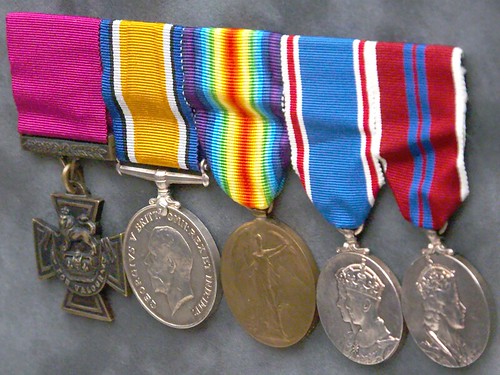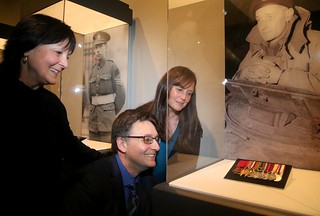
PREV ARTICLE
NEXT ARTICLE
FULL ISSUE
PREV FULL ISSUE
SAVING CANADA'S VICTORIA CROSSESThis article from Canada's National Post describes the Canadian War Museum's campaign to keep in Canada Victoria Cross medals awarded to Canadians. -Editor For Valour.
The Victoria Cross is not an elaborate medal. It's a simple square cross, made of a bronze alloy with a crown and a lion over the inscription. Since it was first created in 1856 it has been awarded to 99 Canadians. The cross has been given to Canadian soldiers for sacrifices on the beaches of Dieppe, the fields of Passchendaele or at Hill 70. They were given to aviators who stayed inside burning planes to free trapped colleagues and a captain who moored his boat in a hostile harbour even as it caught fire. It has been awarded both to those who survived battles and posthumously to those who did not. Of the 99 medals, 39 are in the hands of the Canadian War Museum and the museum wants to ensure all of the medals stay in the country and, as much as possible, are on public view. Eric Fernberg, collections specialist at the museum, said all of the medals were awarded to men who showed remarkable bravery. "It has always been highly regarded as the top award, because the criteria is so high and the sacrifice is so high," he said. "They overrode all sense of self-preservation to be able to do the things that they did speaks to the individuals." He said the medal was also among the first gallantry awards given out regardless of rank. "In 1856, when Queen Victoria instituted it it was her intention that it would be for everybody. It didn't matter if you were a general, a lieutenant colonel or a private. It was for everybody." 
John Kinross Victoria Cross and other medals Fernberg said because of the importance of the medal the museum does keep an eye open for any that come on the market. When sold, the medals now go for hundreds of thousands of dollars at auction. Most are in public institutions of one kind or another, provincial museums and regimental museums. Fernberg said they know where all of the crosses are and make sure potential sellers are aware of the museum interest. Because of their rarity, Victoria Crosses have been rising in value in recent years. The war museum doesn't discuss the prices it pays for the medals, but one of its recent purchases, the medal of Lt.-Col. David Currie, was sold for $660,000 at auction not long before the museum acquired it. The medal was purchased by an unknown buyer, but rules against exporting cultural property prevented it from leaving Canada and the museum was able to come to terms with the auction buyer. The museum's purchase included $220,000 from a special government fund for cultural property like this and was likely close to the $660,000 paid at auction. To read the complete article, see:
 Wayne Homren, Editor The Numismatic Bibliomania Society is a non-profit organization promoting numismatic literature. See our web site at coinbooks.org. To submit items for publication in The E-Sylum, write to the Editor at this address: whomren@gmail.com To subscribe go to: https://my.binhost.com/lists/listinfo/esylum All Rights Reserved. NBS Home Page Contact the NBS webmaster 
|
